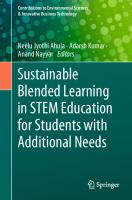Understanding Students with Additional Needs as Learners 3030565955, 9783030565954
This book brings together a compendium of the collaborative research from eight PhD students and three researchers, addr
232 101 6MB
English Pages 231 [244] Year 2021
Table of contents :
Preface
Back Story
Contents
About the Editors
Contributors
Chapter 1: Profiling Developmental Learning for Students with Additional Needs (SWANs)
1.1 Introduction
References
Chapter 2: Competence Assessment
2.1 Introduction
2.2 Measurement
2.3 Instructional Implications
2.4 Reporting
References
Chapter 3: Functional Communication Competence for Students with Additional Needs
3.1 Introduction
3.2 Designing the SWANs Communication Assessment
3.3 Trials of the Communication Assessment
3.4 Development of a Learning Progression
3.5 Using the Learning Progression to Set Instructional Goals
3.6 Using the Learning Progression to Identify Teaching Programs
3.7 Summary
References
Chapter 4: Using Symbols to Make Meaning: Functional Literacy for Students with Additional Needs
4.1 Designing the SWANs Literacy Assessment
4.2 Trial of the Literacy Items
4.3 Development of the Literacy Learning Progressions
4.4 Using the Learning Progression to Identify Teaching Programs
References
Chapter 5: Interpersonal Competence for Students with Additional Needs
5.1 Introduction
5.2 Construction of a Criterion-Referenced Framework for Interpersonal Processes
5.2.1 Using the Insights of Practitioners in the Construction Process
5.2.2 Outlining the Domain of Inquiry
5.2.3 Establishment of Strands
5.2.4 Identifying Capabilities and Behavioural Indicators
5.2.5 Differentiating Performance Quality
5.2.6 Data Collection
5.3 Data Analysis and Continuum Construction
5.4 Discussion
References
Chapter 6: Cognitive Skills – Students with Additional Learning Needs and Autism Spectrum Disorder
6.1 Introduction
6.1.1 Victorian Students with Additional Learning Needs
6.1.2 Related Research
6.2 Methodology
6.2.1 Participants
6.2.2 SWANs Cognitive Skill Instrument
6.2.3 Data Analysis
6.2.4 Establishing Progressions with Expert Panelling
6.3 Results
6.3.1 Initial Analyses
6.3.2 Analyses on Divided Data Set
6.3.3 Empirical Establishment of Progressions
6.4 Discussion
References
Chapter 7: Profiling Transitions in Emotional Development for Students with Additional Learning Needs
7.1 Introduction
7.2 Victorian Essential Learning Standards for Students with Additional Learning Needs
7.3 Importance of Inclusion of Emotional Learning Progress
7.4 Creating a Standards-Referenced Framework
7.4.1 Identification of Components, Indicators and Developmental Criteria
7.4.2 Development of an Observation Questionnaire
7.5 Data Collection
7.6 Calibration of the Observation Questionnaire and Establishment of Levels of Emotion Development
7.7 Comparison of Levels on the Derived Scale of Emotion with VELS Stages of Learning
7.8 Conclusions
References
Chapter 8: The Development of Problem-Solving Rubrics to Define Learning Progressions for Students with Additional Needs
8.1 Introduction
8.2 Method
8.2.1 Participants
8.2.2 Workshops
8.3 Results and Discussion
8.3.1 Review of the Construct Definition
8.3.2 Review of Strands and Capabilities
8.3.3 Review of Indicators of Skill and Understanding
8.3.4 Mapping the Rubrics to a Progression
8.3.5 Targeting Instruction to the Learning Progression
8.4 Conclusion
References
Chapter 9: Assessing and Understanding Early Numeracy for Students with Additional Learning Needs
9.1 Introduction
9.1.1 The Role of the Teacher
9.1.2 Building Learning Progressions from Criterion-Referenced Frameworks
9.2 Method
9.2.1 Participants
9.2.2 Materials
9.2.3 Analysis
9.3 Results and Discussion
9.3.1 Initial Analysis
9.3.2 DIF Analysis
9.4 Conclusion
References
Chapter 10: Understanding and Mapping Digital Literacy for Students with Disability
10.1 Introduction
10.2 Developing and Mapping the Construct
10.2.1 Living in the Digitised World
10.2.2 Digital Technology as Tool or Instrument
10.2.3 Literacy in a Sociocultural Constructivist Framework
10.2.4 Conceptual Approaches to Digital Literacy
10.2.5 Definition of the Construct of Digital Literacy
10.3 Developing the SWANs Digital Literacy Assessment
10.3.1 Applying S. E. Dreyfus and Dreyfus’ (1980) Taxonomy
10.3.2 Drafting the Indicative Behaviours
10.3.3 Drafting the Quality Criteria
10.3.4 Pairwise Comparisons
10.3.5 Piloting and Panelling
10.4 Collecting Data on Student Digital Literacy Ability
10.4.1 Demographic Backgrounds
10.4.2 Psychometric Analysis
10.5 Crafting the Digital Literacy Learning Progression
10.5.1 Setting Cut Points
10.5.2 Developing Level Descriptions
10.5.3 Standard Setting
10.5.4 Extent of the Match – Hypothesised and Derived Progressions
10.6 Summary
References
Chapter 11: Supporting Motor Learning in the Classroom for Students with Motor Performance Needs
11.1 Introduction
11.2 The Development of a Learning Progression
11.3 Sourcing the Findings of Research
11.3.1 An Accessible Domain Description
11.3.2 Conceptualisation of Motor Skill Advance
11.3.3 Classroom-Important Motor Aspects and Skills
11.4 Method
11.4.1 Determining Subject Matter Experts
11.4.2 Achieving a Developmental Description of the Learning Domain
11.4.3 Differential Weighting of Item Steps by Pairwise Comparison
11.4.4 Trialling the Items by Assessment of Students with Physical Disability
11.5 Results
11.5.1 The Multidimensionality of the Learning Domain
11.5.2 Standard Setting
11.5.3 Cut-Points
11.5.4 Devising Level Descriptions
11.6 Conclusion
References
Chapter 12: Thinking Skills Instructional Strategies: Teaching Students with Additional Needs to be Better Thinkers
12.1 Introduction
12.2 Thinking Skills Learning Progression
12.3 Method
12.3.1 Workshop Participants
12.3.2 Materials
12.4 Workshop Activities and Results
12.5 Discussion
12.6 Conclusion
References
Chapter 13: Using Differential Item Functioning to Validate a Judgement-Based Assessment of Emergent Literacy for Students with Autism Spectrum Disorder
13.1 Introduction
13.2 Method
13.2.1 Participants
13.2.2 Materials
13.2.3 The Partial Credit Model and Differential Item Functioning
13.3 Results and Discussion
13.3.1 Differential Step Functioning (DSF)
13.4 Conclusion
References
Chapter 14: A Curriculum for Students with Additional Needs
14.1 Curriculum Design Based on Principles of Equitable Access to Education
14.2 Curriculum Design in Practice
14.3 Abilities Based Learning and Education Support (ABLES)
14.4 Conclusion
References
Appendix: Learning Progressions for Students with Additional Needs
Preface
Back Story
Contents
About the Editors
Contributors
Chapter 1: Profiling Developmental Learning for Students with Additional Needs (SWANs)
1.1 Introduction
References
Chapter 2: Competence Assessment
2.1 Introduction
2.2 Measurement
2.3 Instructional Implications
2.4 Reporting
References
Chapter 3: Functional Communication Competence for Students with Additional Needs
3.1 Introduction
3.2 Designing the SWANs Communication Assessment
3.3 Trials of the Communication Assessment
3.4 Development of a Learning Progression
3.5 Using the Learning Progression to Set Instructional Goals
3.6 Using the Learning Progression to Identify Teaching Programs
3.7 Summary
References
Chapter 4: Using Symbols to Make Meaning: Functional Literacy for Students with Additional Needs
4.1 Designing the SWANs Literacy Assessment
4.2 Trial of the Literacy Items
4.3 Development of the Literacy Learning Progressions
4.4 Using the Learning Progression to Identify Teaching Programs
References
Chapter 5: Interpersonal Competence for Students with Additional Needs
5.1 Introduction
5.2 Construction of a Criterion-Referenced Framework for Interpersonal Processes
5.2.1 Using the Insights of Practitioners in the Construction Process
5.2.2 Outlining the Domain of Inquiry
5.2.3 Establishment of Strands
5.2.4 Identifying Capabilities and Behavioural Indicators
5.2.5 Differentiating Performance Quality
5.2.6 Data Collection
5.3 Data Analysis and Continuum Construction
5.4 Discussion
References
Chapter 6: Cognitive Skills – Students with Additional Learning Needs and Autism Spectrum Disorder
6.1 Introduction
6.1.1 Victorian Students with Additional Learning Needs
6.1.2 Related Research
6.2 Methodology
6.2.1 Participants
6.2.2 SWANs Cognitive Skill Instrument
6.2.3 Data Analysis
6.2.4 Establishing Progressions with Expert Panelling
6.3 Results
6.3.1 Initial Analyses
6.3.2 Analyses on Divided Data Set
6.3.3 Empirical Establishment of Progressions
6.4 Discussion
References
Chapter 7: Profiling Transitions in Emotional Development for Students with Additional Learning Needs
7.1 Introduction
7.2 Victorian Essential Learning Standards for Students with Additional Learning Needs
7.3 Importance of Inclusion of Emotional Learning Progress
7.4 Creating a Standards-Referenced Framework
7.4.1 Identification of Components, Indicators and Developmental Criteria
7.4.2 Development of an Observation Questionnaire
7.5 Data Collection
7.6 Calibration of the Observation Questionnaire and Establishment of Levels of Emotion Development
7.7 Comparison of Levels on the Derived Scale of Emotion with VELS Stages of Learning
7.8 Conclusions
References
Chapter 8: The Development of Problem-Solving Rubrics to Define Learning Progressions for Students with Additional Needs
8.1 Introduction
8.2 Method
8.2.1 Participants
8.2.2 Workshops
8.3 Results and Discussion
8.3.1 Review of the Construct Definition
8.3.2 Review of Strands and Capabilities
8.3.3 Review of Indicators of Skill and Understanding
8.3.4 Mapping the Rubrics to a Progression
8.3.5 Targeting Instruction to the Learning Progression
8.4 Conclusion
References
Chapter 9: Assessing and Understanding Early Numeracy for Students with Additional Learning Needs
9.1 Introduction
9.1.1 The Role of the Teacher
9.1.2 Building Learning Progressions from Criterion-Referenced Frameworks
9.2 Method
9.2.1 Participants
9.2.2 Materials
9.2.3 Analysis
9.3 Results and Discussion
9.3.1 Initial Analysis
9.3.2 DIF Analysis
9.4 Conclusion
References
Chapter 10: Understanding and Mapping Digital Literacy for Students with Disability
10.1 Introduction
10.2 Developing and Mapping the Construct
10.2.1 Living in the Digitised World
10.2.2 Digital Technology as Tool or Instrument
10.2.3 Literacy in a Sociocultural Constructivist Framework
10.2.4 Conceptual Approaches to Digital Literacy
10.2.5 Definition of the Construct of Digital Literacy
10.3 Developing the SWANs Digital Literacy Assessment
10.3.1 Applying S. E. Dreyfus and Dreyfus’ (1980) Taxonomy
10.3.2 Drafting the Indicative Behaviours
10.3.3 Drafting the Quality Criteria
10.3.4 Pairwise Comparisons
10.3.5 Piloting and Panelling
10.4 Collecting Data on Student Digital Literacy Ability
10.4.1 Demographic Backgrounds
10.4.2 Psychometric Analysis
10.5 Crafting the Digital Literacy Learning Progression
10.5.1 Setting Cut Points
10.5.2 Developing Level Descriptions
10.5.3 Standard Setting
10.5.4 Extent of the Match – Hypothesised and Derived Progressions
10.6 Summary
References
Chapter 11: Supporting Motor Learning in the Classroom for Students with Motor Performance Needs
11.1 Introduction
11.2 The Development of a Learning Progression
11.3 Sourcing the Findings of Research
11.3.1 An Accessible Domain Description
11.3.2 Conceptualisation of Motor Skill Advance
11.3.3 Classroom-Important Motor Aspects and Skills
11.4 Method
11.4.1 Determining Subject Matter Experts
11.4.2 Achieving a Developmental Description of the Learning Domain
11.4.3 Differential Weighting of Item Steps by Pairwise Comparison
11.4.4 Trialling the Items by Assessment of Students with Physical Disability
11.5 Results
11.5.1 The Multidimensionality of the Learning Domain
11.5.2 Standard Setting
11.5.3 Cut-Points
11.5.4 Devising Level Descriptions
11.6 Conclusion
References
Chapter 12: Thinking Skills Instructional Strategies: Teaching Students with Additional Needs to be Better Thinkers
12.1 Introduction
12.2 Thinking Skills Learning Progression
12.3 Method
12.3.1 Workshop Participants
12.3.2 Materials
12.4 Workshop Activities and Results
12.5 Discussion
12.6 Conclusion
References
Chapter 13: Using Differential Item Functioning to Validate a Judgement-Based Assessment of Emergent Literacy for Students with Autism Spectrum Disorder
13.1 Introduction
13.2 Method
13.2.1 Participants
13.2.2 Materials
13.2.3 The Partial Credit Model and Differential Item Functioning
13.3 Results and Discussion
13.3.1 Differential Step Functioning (DSF)
13.4 Conclusion
References
Chapter 14: A Curriculum for Students with Additional Needs
14.1 Curriculum Design Based on Principles of Equitable Access to Education
14.2 Curriculum Design in Practice
14.3 Abilities Based Learning and Education Support (ABLES)
14.4 Conclusion
References
Appendix: Learning Progressions for Students with Additional Needs

![Understanding Students with Additional Needs as Learners [1st ed.]
9783030565954, 9783030565961](https://ebin.pub/img/200x200/understanding-students-with-additional-needs-as-learners-1st-ed-9783030565954-9783030565961.jpg)



![Assessing learners with special needs: an applied approach [Pearson New international edition.,Seventh edition]
1292025123, 9781292025124](https://ebin.pub/img/200x200/assessing-learners-with-special-needs-an-applied-approach-pearson-new-international-editionseventh-edition-1292025123-9781292025124.jpg)

![Inclusive Instruction: Evidence-Based Practices for Teaching Students with Disabilities (What Works for Special-Needs Learners) [1 ed.]
1462503888, 9781462503889](https://ebin.pub/img/200x200/inclusive-instruction-evidence-based-practices-for-teaching-students-with-disabilities-what-works-for-special-needs-learners-1nbsped-1462503888-9781462503889.jpg)
![Going Places Transition Scheme : Supporting Children with Additional Needs into Secondary School [1 ed.]
9781351692939, 9780863889219](https://ebin.pub/img/200x200/going-places-transition-scheme-supporting-children-with-additional-needs-into-secondary-school-1nbsped-9781351692939-9780863889219.jpg)
![Meeting the Needs of Disaffected Students : Engaging Students with Social, Emotional and Behavioural Difficulties [1 ed.]
9781855394377, 9780826434654](https://ebin.pub/img/200x200/meeting-the-needs-of-disaffected-students-engaging-students-with-social-emotional-and-behavioural-difficulties-1nbsped-9781855394377-9780826434654.jpg)
